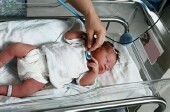
TUESDAY, July 12 (HealthDay News) — Using an invasive procedure to diagnosis lung infections in infants with cystic fibrosis does not improve their long-term outcomes, a new study finds.
Lung infections in children with cystic fibrosis are associated with increased risk of illness and death.
Australian researchers examined the use of bronchoalveolar lavage (BAL), an alternative diagnostic procedure used when young children with CF can’t provide sputum for analysis. BAL involves inserting a bronchoscope through the nose or mouth to collect a sample of fluid from the lungs.
The study found that the 79 infants with CF who were treated for infection based on a diagnosis using BAL did not have a lower rate of lung-damaging infection or structural lung injury by the time they were 5 years old, compared with the 76 infants with CF who were diagnosed with lung infections using the standard procedure.
The study appears in the July 13 issue of the Journal of the American Medical Association.
“BAL-directed therapy provided no clinical, microbiologic or radiographic advantage, and led to an increased risk of predominantly mild adverse events as a direct result of bronchoscopy as well as disadvantages such as the need to fast prior to the procedure, exposure to anesthesia and potential perioperative anxiety,” concluded Dr. Claire E. Wainwright, Royal Children’s Hospital, University of Queensland, Brisbane, and colleagues.
More information
The Cystic Fibrosis Foundation has more about cystic fibrosis.

